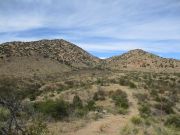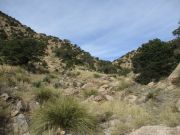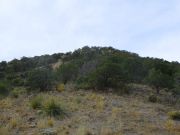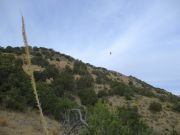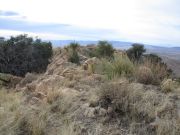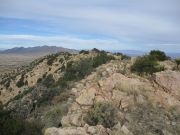
The Mountains of Arizona
• www.surgent.net
|
| OK Notch Peak |
• Dragoon Mountains • Arizona State Trust Land • Cochise County |
|
Date: December 12, 2023
• Elevation: 6,487 feet ✳
• Prominence: 1,084 feet ✳
• Distance: 4.8 miles
• Time: 3 hours and 15 minutes
• Gain: 1,260 feet
• Conditions: High clouds, cool, clearing later, breezy
Arizona
•
Main
•
AZ P1K
•
PB
•
LoJ
•
Lidar
This peak rises a dozen miles east of Tombstone, near the quasi-ghost-town of Gleeson. It does not have a formal name, but a notch is labeled "OK Notch" on the map, which then becomes this peak's unofficial name. Why a notch gets a name and a summit doesn't is a good question. Maybe there was a gunfight at this notch back in the 1800s, which made it famous.
I had a day open from post-semester grading and zoom meetings, so I looked for something to do. I'd been aware of this peak and now being based in Bisbee, getting to it would not take long. I was on the road at 7:45, the day clouded over in that sheen-like cloud cover that dulls the sunlight and makes everything tan or gray. But this was expected to move on during the afternoon.
I stopped in Tombstone for snacks, then followed Gleeson Road east from Tombstone, driving to a gate on the north side between mileposts 12 and 13. I was southeast of the peak. This road is gated but not locked. It crosses a square-mile section of State Trust land. The sign on the gate was faded and probably hung there in 1950.
The road was marginal. I drove in about a half mile, parking on a bluff, the elevation here about 5,230 feet. It was still cool and gray, but not bitterly cold. The clouds kept in any ambient warmth, so the temperature was in the 50s and it was humid, although not uncomfortable. I was suited up and walking at 8:45.
I followed the road north, coming to another gate at the north edge of the State Trust section. The wire strands on this gate were so loose that I just stepped over them. I stayed on the road as it bent northwesterly, going right at one junction and left at another, all the while aiming for the small canyon that lies east of the peak and between a small ridge that comes off the massif. I walked until I was at the end of the last road, elevation 5,600 feet.
There's not much information on this peak. Matthias Stender and Wade Luther from Peakbagger both supplied GPS tracks, one going up this canyon but both coming directly down the east slopes. I'd figure this out as I went along. However, I felt that going up the canyon seemed like a good idea, so that's what I did.
At the end of the road, a weak path continued into the canyon. This appeared to be a cattle path, and a few "poo cairns" along the way confirmed this. It would likely be followed by the occasional person venturing here, on a hunt perhaps. I followed the path whenever I could, but also dropped into the drainage too. Then I'd ascend out of it and pick up the path again.
There was a point where even the cows didn't venture higher, and any semblance of a path had disappeared. But the drainage, much to my relief, wasn't too shabby. It was mostly clear of brush, the rocks weren't too big or jumbled, and at worst, I had to scale a 4-foot step. I made good time up this drainage.
The drainage makes a bend to the left and starts to narrow as it gains its rocky headwall below the actual OK Notch. I stopped for a break to study my options and have a drink. I had been hiking one hour.
I ascended out of the drainage to my left as I looked up. About 50 feet later, I was on top of a steeply-sloping ridge that appeared to lead right to the range crest. I had just enough visibility to make out the main features and gather my bearings. It was more forested up here so line-of-sight was often limited. I was at approximately 6,160 feet elevation, and the ridge was about 300 feet higher.
I started up slope, which wasn't troublesome at first. It steepened incrementally until it met the lowest of the rock outcrops. These rock outcrops tended to slope back but covered in gravel, thus not being very stable to stand upon. I generally hiked along the slope-rock margins. The slopes were loose and steep, and often the most attractive, safest and logical route had a big tree growing right on it. I spent a lot of time busting dead branches and moving crud so that I could get through it. I tied a couple surveyor ribbons at strategic spots so I could find my way down later.
This segment just went slow but was never exposed or dangerous. The scrambling was just Class-2, but sloppy. Footing was the main issue. I had to make sure my feet weren't suddenly going to slide out from under me. All the while, some guy in a small airplane was buzzing the range. He'd suddenly fly over from the west side to the east side, then go north a couple miles, then come back and repeat the pattern, always the same each time. He must have made two dozen such iterations, and by about the 12th one I was growing tired of him and the noise. It was disconcerting to have him suddenly appear over the ridge and that loud motor noise, which was actually quite loud given I was pretty close to him. He probably never knew I was there. What he was doing, and why, I have no idea. In about twenty minutes, I had arrived onto the top ridge, which felt good. The sun was starting to break out now. But being on the ridge, the steady breeze was chilling.
I made a left and hiked southbound, following a path, gaining about 30 feet to top out on the first summit. From here I could see the rest of the ridge, including its equally-high southern summit and the rocks and trees in between. Past visitors surmised that by observation alone, the two summits are essentially equal in height.
I walked along the ridge and tagged anything that looked high. I got to a dull knife-edge that I didn't like, so I backtracked a little and dropped about fifteen feet downslope to ease past this, and then up fifteen feet to place me on the home stretch to the southern summit. Again, I tagged all highest rocks. Looking back, I couldn't be sure what was highest.
On the way back, I repeated my route and tagged more rock outcrops. I got to the one (the north summit) that I felt "looked" highest and found a register in a crevice below the top rock. I signed in, the first since Matthias back in May. I had another quick drink, but the cool breeze and my desire to get down the sloppy slopes while I still remembered what to do prompted me to keep moving. I spent about ten minutes tagging the summit, maybe one minute actually sitting for a break.
Going down, I inched slowly down the loose regolith, coming to my ribbons and untying them. I took a few segments on all fives, and just moved carefully, careful not to slip or go for an unplanned "ski" on the rubble. Shortly, I was below the steepest of the rocks and back on more open, gentle slopes. I then found my way back into the drainage and sat for a couple minutes on a convenient rock to have my "summit" break. It felt good to be down off those slopes, back in the relative safety of the drainage.
The hike down went well, using gravity to assist. I got back onto the roads and back to my car at noon on the dot, a three-hour and fifteen-minute hike. The sun was out now so I stopped often for photos. The ones you see here were taken on the descent.
For the drive home, I continued east on Gleeson Road, passing through Gleeson itself. We were here back in 2010. It has some old historical buildings from the late 19th century, but no actual "town center". There are no gas stations, mini marts or notary public services here. But people do live here, in scattered "ranchette" properties. I was home a little after 1 p.m..
The Lidar data here has been mapped to the 1-meter detail, which is good. So the natural question is, are the two summits of equal height? Or is one a smidge higher? Turns out that Lidar gives the same elevation, 6,487 feet, for both the north and south summits, and a 6,486-foot spot elevation for one in between. The older topographic maps just show two 6,480-foot contours but no finer detail. I checked its key-col elevation as well, and it reports an elevation of 5,403 feet. Thus, the peak's prominence comes in at 1,084 feet, which is significantly higher than the estimated 1,040-foot value based on the map alone.
This also happened to be my 200th peak climbed in Arizona with a minimum of 1,000 feet of prominence. I'd been kinda working toward his goal for a couple years, and it felt good to finally get the magical Number 200.
|
|

